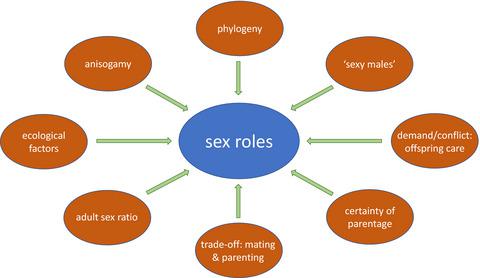Our official English website, www.x-mol.net, welcomes your feedback! (Note: you will need to create a separate account there.)
The evolution of reversed sex roles and classical polyandry: Insights from coucals and other animals
Ethology ( IF 1.7 ) Pub Date : 2020-10-07 , DOI: 10.1111/eth.13095 Ignas Safari 1, 2, 3 , Wolfgang Goymann 1, 2
Ethology ( IF 1.7 ) Pub Date : 2020-10-07 , DOI: 10.1111/eth.13095 Ignas Safari 1, 2, 3 , Wolfgang Goymann 1, 2
Affiliation

|
In most animals, competition for mating opportunities is higher among males, whereas females are more likely to provide parental care. In few species, though, these "conventional" sex roles are reversed such that females compete more strongly for matings and males provide most or all parental care. This "reversal" in sex roles is often combined with classical polyandry—a mating system in which a female forms a harem with several males. Here, we review the major hypotheses relating such role reversals to evolutionary and behavioural traits (anisogamy, phylogenetic history, sexy males, parental care, genetic paternity, trade‐off between mating and parenting, adult sex ratio) and to ecological factors (food supply, offspring predation). We evaluate each hypothesis in relation to coucals (Centropodinae), a group of nesting cuckoos of great interest for mating system and parental care theory. The black coucal (Centropus grillii) is the only known bird combining classical polyandry with altricial development of young, a costly trait with regard to parental care. Our long‐term study offers a unique possibility to compare the strongly polyandrous black coucal with a monogamous close relative breeding in the same area and habitat, the white‐browed coucal (C. superciliosus). We show that the evolution of sex roles in coucals and other animals has many different facets. Whereas phylogenetic constraints are important, confidence in genetic paternity is not. In combination with facilitating ecological conditions, adult sex ratios are key to understanding sex roles in coucals, shorebirds, and most likely also other animals. We plead for more studies including experimental tests to understand how biased adult sex ratios emerge and whether they drive sexual selection or vice versa. How do sex ratios and sexual selection interact and feedback on each other? Answers to these questions will be fundamental for understanding the evolution of sex roles in mating and parenting in coucals and other species.
中文翻译:

颠倒的性角色和经典一妻多夫制的演变:库卡人和其他动物的见解
在大多数动物中,雄性对交配机会的竞争较高,而雌性更可能提供父母照料。但是,在少数物种中,这些“常规”性角色被逆转,使得雌性在交配方面竞争更激烈,而雄性则提供大部分或全部育儿服务。这种性别角色上的“逆转”通常与经典的一妻多夫制相结合。一夫一妻制的交配系统中,雌性与数个雄性形成后宫。在这里,我们回顾了主要的假设,这些假设将这种角色反转与进化和行为特征(同性配偶,系统发育史,性感男性,父母育儿,遗传亲子关系,交配与养育之间的权衡,成年男女比例)以及生态因素(食物供应)相关,后代捕食)。我们评估与coucals(Centropodinae)有关的每个假设,一组对交配系统和育儿理论非常感兴趣的筑巢杜鹃。黑色coucal(Centropus grillii)是唯一已知的将经典一夫多妻制与幼龄的幼体发育结合起来的鸟类,这是父母育儿方面的一项昂贵特性。我们的长期研究提供了一种独特的可能性,可以将在同一地区和栖息地的一夫一妻制的黑双吻cal与一夫一妻的近亲繁殖(白眉双吻()进行比较。)。我们表明,在双唇和其他动物中性角色的进化具有许多不同的方面。虽然系统发育限制很重要,但对遗传亲子关系的信心并不重要。与有利的生态条件相结合,成年性别比对于了解库库尔人,水鸟和其他动物中的性角色至关重要。我们恳求进行更多的研究,包括实验测试,以了解有偏见的成人性别比例是如何产生的以及它们是否会导致性别选择,反之亦然。性别比和性别选择如何相互作用和相互反馈?这些问题的答案对于理解双性恋和其他物种在交配和育儿中性别角色的演变至关重要。
更新日期:2020-12-14
中文翻译:

颠倒的性角色和经典一妻多夫制的演变:库卡人和其他动物的见解
在大多数动物中,雄性对交配机会的竞争较高,而雌性更可能提供父母照料。但是,在少数物种中,这些“常规”性角色被逆转,使得雌性在交配方面竞争更激烈,而雄性则提供大部分或全部育儿服务。这种性别角色上的“逆转”通常与经典的一妻多夫制相结合。一夫一妻制的交配系统中,雌性与数个雄性形成后宫。在这里,我们回顾了主要的假设,这些假设将这种角色反转与进化和行为特征(同性配偶,系统发育史,性感男性,父母育儿,遗传亲子关系,交配与养育之间的权衡,成年男女比例)以及生态因素(食物供应)相关,后代捕食)。我们评估与coucals(Centropodinae)有关的每个假设,一组对交配系统和育儿理论非常感兴趣的筑巢杜鹃。黑色coucal(Centropus grillii)是唯一已知的将经典一夫多妻制与幼龄的幼体发育结合起来的鸟类,这是父母育儿方面的一项昂贵特性。我们的长期研究提供了一种独特的可能性,可以将在同一地区和栖息地的一夫一妻制的黑双吻cal与一夫一妻的近亲繁殖(白眉双吻()进行比较。)。我们表明,在双唇和其他动物中性角色的进化具有许多不同的方面。虽然系统发育限制很重要,但对遗传亲子关系的信心并不重要。与有利的生态条件相结合,成年性别比对于了解库库尔人,水鸟和其他动物中的性角色至关重要。我们恳求进行更多的研究,包括实验测试,以了解有偏见的成人性别比例是如何产生的以及它们是否会导致性别选择,反之亦然。性别比和性别选择如何相互作用和相互反馈?这些问题的答案对于理解双性恋和其他物种在交配和育儿中性别角色的演变至关重要。

























 京公网安备 11010802027423号
京公网安备 11010802027423号